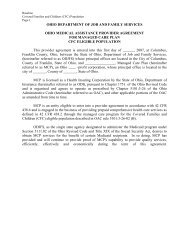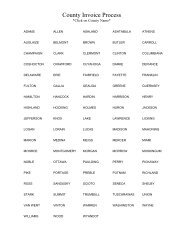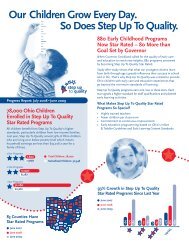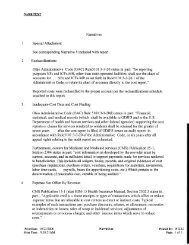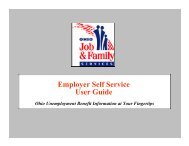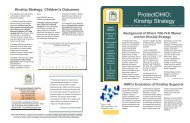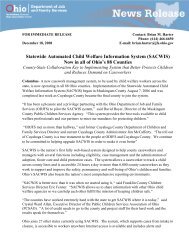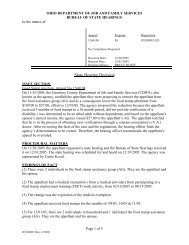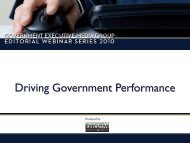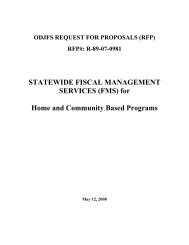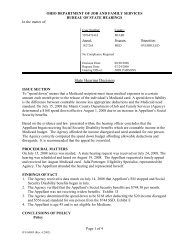Final TANF Rule as published in the Federal Register 4/12/1999
Final TANF Rule as published in the Federal Register 4/12/1999
Final TANF Rule as published in the Federal Register 4/12/1999
You also want an ePaper? Increase the reach of your titles
YUMPU automatically turns print PDFs into web optimized ePapers that Google loves.
<strong>Federal</strong> <strong>Register</strong> / Vol. 64, No. 69 / Monday, April <strong>12</strong>, <strong>1999</strong> / <strong>Rule</strong>s and Regulations<br />
parent’s demonstrated <strong>in</strong>ability must be<br />
for one or more of <strong>the</strong> follow<strong>in</strong>g re<strong>as</strong>ons:<br />
• Appropriate child care with<strong>in</strong> a<br />
re<strong>as</strong>onable distance from <strong>the</strong><br />
<strong>in</strong>dividual’s home or work site is<br />
unavailable;<br />
• Informal child care by a relative or<br />
under o<strong>the</strong>r arrangements is unavailable<br />
or unsuitable; or<br />
• Appropriate and affordable formal<br />
child care arrangements are unavailable.<br />
Refusal to work when <strong>the</strong> State<br />
determ<strong>in</strong>es an acceptable form of child<br />
care is available is not protected from<br />
sanction<strong>in</strong>g.<br />
Because each State h<strong>as</strong> <strong>the</strong> authority<br />
to determ<strong>in</strong>e whe<strong>the</strong>r <strong>the</strong> <strong>in</strong>dividual h<strong>as</strong><br />
adequately demonstrated an <strong>in</strong>ability to<br />
obta<strong>in</strong> needed child care, we expect <strong>the</strong><br />
State to def<strong>in</strong>e <strong>the</strong> terms ‘‘appropriate<br />
child care,’’ ‘‘re<strong>as</strong>onable distance,’’<br />
‘‘unsuitability of <strong>in</strong>formal care,’’ and<br />
‘‘affordable child care arrangements.’’<br />
The State must also provide families<br />
with <strong>the</strong> criteria (<strong>in</strong>clud<strong>in</strong>g <strong>the</strong><br />
def<strong>in</strong>itions) that it applies <strong>in</strong><br />
implement<strong>in</strong>g <strong>the</strong> exception and <strong>the</strong><br />
means by which a parent can<br />
demonstrate an <strong>in</strong>ability to obta<strong>in</strong><br />
needed child care.<br />
To keep families mov<strong>in</strong>g toward selfsufficiency<br />
and to promote State<br />
compliance with this penalty exception,<br />
our rules provide that States must have<br />
processes or procedures <strong>in</strong> place that:<br />
(1) enable a family to demonstrate its<br />
<strong>in</strong>ability to obta<strong>in</strong> needed child care; (2)<br />
<strong>in</strong>form parents that <strong>the</strong> family’s benefits<br />
cannot be reduced or term<strong>in</strong>ated when<br />
<strong>the</strong>y demonstrate that <strong>the</strong>y are unable to<br />
work due to <strong>the</strong> lack of needed child<br />
care for a child under <strong>the</strong> age of six; and<br />
(3) advise parents that <strong>the</strong> time dur<strong>in</strong>g<br />
which <strong>the</strong>y are excepted from <strong>the</strong><br />
penalty will still count toward <strong>the</strong> time<br />
limit on <strong>Federal</strong> benefits at section<br />
408(a)(7) of <strong>the</strong> Act, if applicable.<br />
In response to numerous comments,<br />
<strong>as</strong> discussed below, <strong>the</strong> language <strong>in</strong><br />
§§ 261.56 and 261.57 reflects <strong>the</strong>se<br />
expectations. In this section, which<br />
focuses on <strong>the</strong> responsibilities of <strong>the</strong><br />
State to <strong>in</strong>form parents, we also require<br />
that <strong>the</strong> <strong>in</strong>formation States provide must<br />
<strong>in</strong>clude <strong>the</strong> def<strong>in</strong>itions or criteria that<br />
<strong>the</strong> State uses <strong>in</strong> its determ<strong>in</strong>ation<br />
process.<br />
The regulations for <strong>the</strong> Child Care and<br />
Development Fund (CCDF) re<strong>in</strong>force <strong>the</strong><br />
importance of provid<strong>in</strong>g this vital<br />
<strong>in</strong>formation to parents by also requir<strong>in</strong>g<br />
<strong>the</strong> child care lead agency, <strong>as</strong> part of its<br />
consumer education efforts, to <strong>in</strong>form<br />
<strong>TANF</strong> parents seek<strong>in</strong>g child care <strong>in</strong> <strong>the</strong><br />
CCDF system of <strong>the</strong> existence of <strong>the</strong><br />
child care exception and how to<br />
demonstrate an <strong>in</strong>ability to obta<strong>in</strong><br />
needed child care.<br />
The CCDF rule requires <strong>the</strong> lead<br />
agency for child care to coord<strong>in</strong>ate with<br />
<strong>the</strong> <strong>TANF</strong> agency <strong>in</strong> order to understand<br />
how <strong>the</strong> <strong>TANF</strong> agency def<strong>in</strong>es and<br />
applies <strong>the</strong> terms of <strong>the</strong> statute<br />
regard<strong>in</strong>g <strong>the</strong> penalty exception and to<br />
<strong>in</strong>clude <strong>the</strong> def<strong>in</strong>itions of <strong>the</strong> terms or<br />
criteria <strong>in</strong> <strong>the</strong> CCDF plan.<br />
We took this child care rule <strong>in</strong>to<br />
consideration <strong>in</strong> draft<strong>in</strong>g our proposed<br />
rule. Under § 271.15, we required that<br />
<strong>the</strong> def<strong>in</strong>itions and criteria be<br />
submitted, but did not specifically<br />
require that <strong>the</strong> <strong>TANF</strong> agency submit<br />
<strong>the</strong>m. Our goal w<strong>as</strong> to ensure that this<br />
<strong>in</strong>formation w<strong>as</strong> available for audit and<br />
penalty purposes and that it be part of<br />
<strong>the</strong> public record, not to create an<br />
unnecessary burden for States. We have<br />
not altered this policy <strong>in</strong> <strong>the</strong>se f<strong>in</strong>al<br />
regulations.<br />
We received many comments on <strong>the</strong><br />
provisions <strong>in</strong> this section and made<br />
changes <strong>as</strong> discussed below.<br />
Comment: Most commenters objected<br />
to hav<strong>in</strong>g <strong>the</strong> responsibility for<br />
<strong>in</strong>form<strong>in</strong>g families about <strong>the</strong> child care<br />
exemption <strong>in</strong> <strong>the</strong> hands of <strong>the</strong> child care<br />
lead agency and urged that we give <strong>the</strong><br />
responsibility to <strong>the</strong> <strong>TANF</strong> agency.<br />
Response: In <strong>the</strong> NPRM, we did not<br />
specifically require <strong>the</strong> <strong>TANF</strong> agency to<br />
<strong>in</strong>form clients about <strong>the</strong> exception to<br />
sanction<strong>in</strong>g because <strong>the</strong> CCDF NPRM<br />
(now <strong>the</strong> CCDF f<strong>in</strong>al rule) already<br />
required it. In <strong>the</strong> NPRM preamble, we<br />
stated our expectation that States would<br />
<strong>in</strong>form clients, but did not name <strong>the</strong><br />
entity responsible. Our <strong>in</strong>tent w<strong>as</strong> to<br />
avoid impos<strong>in</strong>g an additional <strong>Federal</strong><br />
burden on <strong>the</strong> States where <strong>the</strong> CCDF<br />
requirement addressed <strong>the</strong> situation<br />
adequately. However, advocates and<br />
States alike made a compell<strong>in</strong>g<br />
argument that not all <strong>TANF</strong> clients<br />
covered by this protection would<br />
necessarily be referred to <strong>the</strong> child care<br />
lead agency. Therefore, we have revised<br />
<strong>the</strong> regulatory language at § 261.56. In<br />
<strong>the</strong> f<strong>in</strong>al rule, <strong>the</strong> <strong>TANF</strong> agency must<br />
<strong>in</strong>form clients of <strong>the</strong> existence of <strong>the</strong><br />
child care exception to sanctions and<br />
how to demonstrate an <strong>in</strong>ability to<br />
obta<strong>in</strong> needed child care. This<br />
requirement is <strong>in</strong> addition to <strong>the</strong><br />
requirement, <strong>in</strong> <strong>the</strong> CCDF rules, that <strong>the</strong><br />
CCDF agency <strong>in</strong>form <strong>TANF</strong> parents<br />
about <strong>the</strong> exception.<br />
Comment: Many States objected to<br />
our requir<strong>in</strong>g criteria and def<strong>in</strong>itions,<br />
argu<strong>in</strong>g that we had shifted <strong>the</strong> burden<br />
of proof from <strong>the</strong> <strong>in</strong>dividual to <strong>the</strong> State.<br />
We also received a few general<br />
comments to <strong>the</strong> effect that our rules did<br />
not adequately protect <strong>in</strong>dividuals from<br />
harsh State policies.<br />
Response: We do not believe that<br />
requir<strong>in</strong>g States to <strong>in</strong>form parents of<br />
<strong>the</strong>ir rights, <strong>in</strong>clud<strong>in</strong>g <strong>the</strong> def<strong>in</strong>ition of<br />
17795<br />
key terms <strong>in</strong> those rights, shifts <strong>the</strong><br />
burden of proof to States. The<br />
<strong>in</strong>dividual needs to know how <strong>the</strong> State<br />
def<strong>in</strong>es key terms to determ<strong>in</strong>e whe<strong>the</strong>r<br />
<strong>the</strong> exception applies to his or her c<strong>as</strong>e.<br />
Regard<strong>in</strong>g <strong>the</strong> concern over harsh<br />
State policies, States have considerable<br />
latitude <strong>in</strong> implement<strong>in</strong>g <strong>the</strong> child care<br />
protections. We th<strong>in</strong>k <strong>the</strong> f<strong>in</strong>al<br />
regulations protect families <strong>as</strong> much <strong>as</strong><br />
possible, given <strong>the</strong> regulatory restra<strong>in</strong>ts<br />
of section 417.<br />
Comment: A few commenters urged<br />
us to require States to <strong>in</strong>form recipients<br />
about available child care subsidies and<br />
to <strong>as</strong>sist <strong>the</strong>m <strong>in</strong> obta<strong>in</strong><strong>in</strong>g appropriate<br />
and affordable child care.<br />
Response: While we agree that<br />
<strong>as</strong>sist<strong>in</strong>g recipients locate child care is<br />
a re<strong>as</strong>onable expectation, <strong>the</strong> statute at<br />
section 417 limits our ability to regulate<br />
<strong>in</strong> this area. Given that child care is<br />
widely recognized <strong>as</strong> a fundamental<br />
supportive service, necessary for<br />
recipients to obta<strong>in</strong> and ma<strong>in</strong>ta<strong>in</strong><br />
employment, we are confident that<br />
States will adopt practices that <strong>in</strong>form<br />
recipients about available child care<br />
providers. States understand <strong>the</strong><br />
importance of employment retention<br />
and career advancement for recipients.<br />
In fact, <strong>the</strong> publication ‘‘Work<strong>in</strong>g Out of<br />
Poverty’’ by <strong>the</strong> NGA Center for Best<br />
Practices, recognizes <strong>the</strong> need to <strong>in</strong>form<br />
recipients of <strong>the</strong> availability of<br />
transitional supports such <strong>as</strong> child care<br />
and transportation <strong>as</strong>sistance early, for<br />
example, dur<strong>in</strong>g eligibility<br />
determ<strong>in</strong>ations and <strong>as</strong>sessments, and <strong>as</strong><br />
part of job search and job read<strong>in</strong>ess<br />
programs.<br />
Comment: Some commenters were<br />
concerned that <strong>the</strong> NPRM left room for<br />
a parent who wishes to use a particular<br />
type of child care that is not available<br />
to refuse appropriate available child<br />
care arrangements, without risk of a<br />
penalty. For example, <strong>the</strong>y feared that a<br />
parent who wants only <strong>in</strong>formal relative<br />
care, but h<strong>as</strong> no relative available to<br />
provide care, could refuse affordable,<br />
suitable center-b<strong>as</strong>ed care. States argue<br />
that this result would be contrary to<br />
Congressional <strong>in</strong>tent and <strong>the</strong> goals of <strong>the</strong><br />
Act. They urged us to make clear that<br />
refus<strong>in</strong>g work under such circumstances<br />
is not protected under <strong>the</strong> child care<br />
exception to a sanction.<br />
Response: This issue stems from an<br />
<strong>in</strong>terpretation of <strong>the</strong> word<strong>in</strong>g of <strong>the</strong><br />
statute, which uses <strong>the</strong> phr<strong>as</strong>e ‘‘one or<br />
more’’ <strong>in</strong> describ<strong>in</strong>g <strong>the</strong> re<strong>as</strong>ons for a<br />
parent’s demonstrated <strong>in</strong>ability to<br />
obta<strong>in</strong> needed child care. However, we<br />
agree with <strong>the</strong> commenters that such a<br />
result would be contrary to<br />
Congressional <strong>in</strong>tent, which w<strong>as</strong> to<br />
protect <strong>in</strong>dividuals from sanction when<br />
<strong>the</strong>re w<strong>as</strong> no appropriate child care, not



